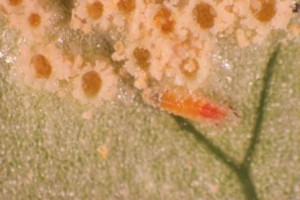This is the parasitic rust fungus Puccinia sessilis stated to be rather rare on Arum maculatum. Many rusts manage the difficult trick of parasitising two entirely unrelated host plants, in both cases establishing a close relationship which allows the fungus to grow on still-living plant tissue. The spores produced by the life-stage shown here will infect the showy Phalaris arundinacea – reed canary grass; cycles of infection on that host will culminate in the production of haploid spores which will infect A. maculatum, mate within it and then produce these “cluster-cup”s (aecia), to complete the life-cycle.
The small fly larva is a species of Mycodiplosis, some species of which specialise in eating rust spores; they are very common on some species of rust, and the adults can presumably smell their way to sporing infections.




